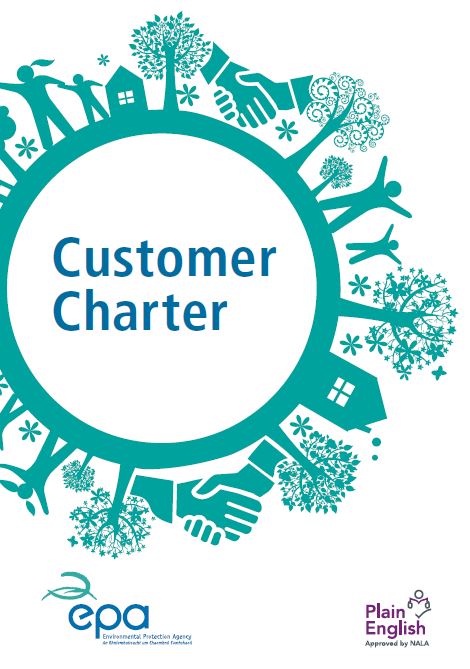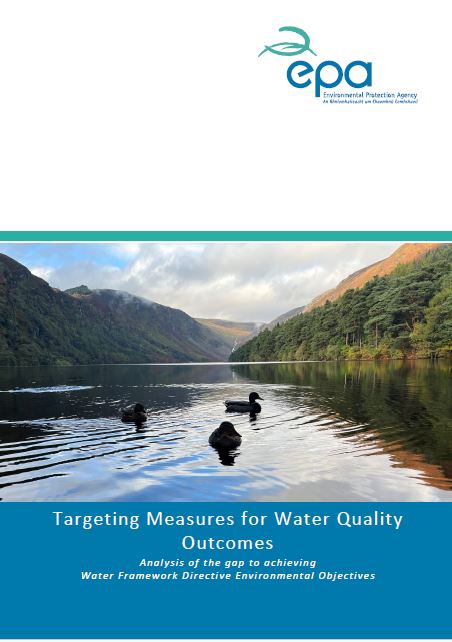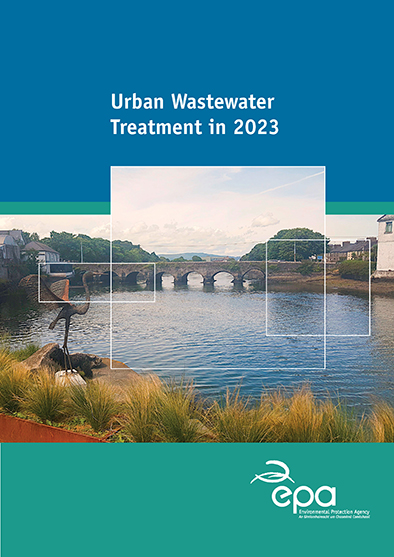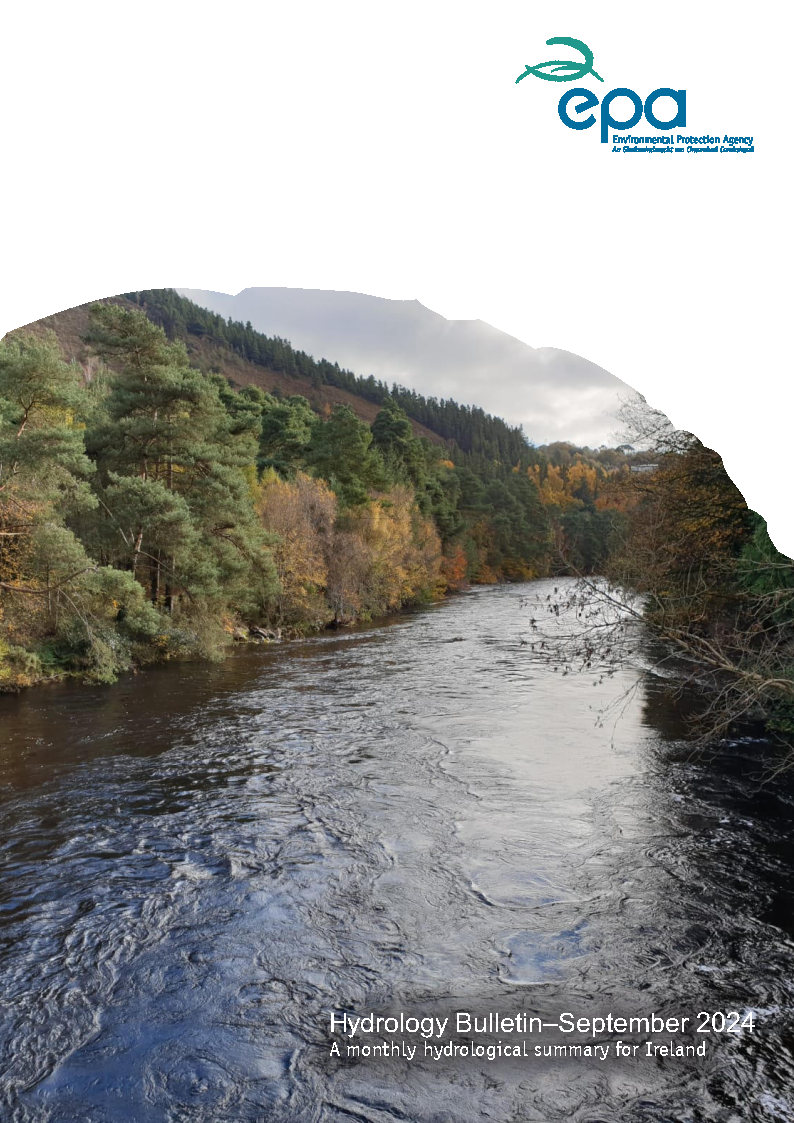
Year: 2024
The EPA has launched a new series of quarterly greenhouse gas emissions for Ireland to support more frequent monitoring of national and sectoral progress on climate action. The series will complement the national greenhouse gas inventory and projections prepared annually by the EPA. The data from the first three months of this year show an overall reduction of 2.2 per cent compared to quarter 1 2023, and a 0.2 per cent increase on quarter 4 2023. It should be noted that these data have been seasonally adjusted to provide a clearer picture of the underlying trends independent of seasonal fluctuations.

Year: 2024
Details the standards that customers and the public can expect in their dealings with the Environmental Protection Agency.

Authors: Nithiya Streethran, Kieran Hickey, Astrid Wingler and Paul Leahy, October 2024
Year: 2024
Ireland’s temperate climate favours almost year-round grass growth, which has supported the development of a successful pasture-based farming system. However, this has been threatened by repeated severe shortfalls in fodder stocks, with resulting impacts on yields, revenues, and animal welfare. Grass growth may be influenced by a number of factors, including droughts, heat stress and other drivers, which can lead to the emergence of a fodder crisis. This research identified the key drivers of historic fodder crises, and investigated whether such events will become more or less frequent or severe under the climatic changes projected for Ireland. An impact-based five-level fodder crisis severity index has also been designed to classify fodder crisis events. The research recommends the need for measures to avoid the emergence of multi-annual events, these include increases in stored fodder provision, early warning systems and earlier closure in autumn to help growth recovery in spring.
Uimhir phoist: 000441, October 2024
Year: 2024
Tá Oifigeach Sinsearach Acmhainní Daonna á earcú ag an EPA chun maoirseacht a dhéanamh ar bhainistíocht Chlár Acmhainní Daonna agus Forbartha (HRD) an EPA. Tá ceithre aonad sa Chlár: Tallann agus Acmhainní; Forbairt Daoine agus Eagrúcháin, Sláinte, Sábháilteacht agus Leas, agus Seirbhísí AD agus Comhlíonadh.
Uimhir phoist: 000442, October 2024
Year: 2024
Tá rialachas corparáideach ríthábhachtach don EPA chun a sainchúram reachtúil a chomhlíonadh go héifeachtach. Tá Aonad Rialachais Chorparáidigh ag an EPA chun ceanglais an Chóid Chleachtais um Rialachas Comhlachtaí Stáit (2016) chomh maith le feidhmeanna rialachais chorparáidigh eile a mhaoirsiú agus a chur i bhfeidhm.

Post Number: 000441, October 2024
Year: 2024
The EPA is recruiting a Senior Human Resources Officer to oversee the management of the EPA’s Human Resources & Development (HRD) Programme. The Programme contains four units: Talent and Resourcing; People and Organisational Development, Health, Safety and Welfare, and HR Services and Compliance.

Post Number: 000442, October 2024
Year: 2024
Corporate governance is vitally important for the EPA in effectively discharging its statutory remit. The EPA has a Corporate Governance Unit to specifically oversee and implement the requirements of the Code of Practice for the Governance of State Bodies (2016) as well as other corporate governance functions.

Year: 2024
Understanding the state of Ireland's water quality and the effectiveness of planned measures is crucial for ensuring a sustainable future. This analysis, focusing on the Third Cycle Water Action Plan 2024, is based on data as of September 2023. The final Water Action Plan, which was published in September 2024, has been informed by, and includes information from, the EPA’s gap analysis of the draft Plan.
Year: 2024
Year: 2024

Year: 2024
This report provides an overview of urban wastewater treatment in Ireland during 2023. It highlights the priority issues that Uisce Éireann must address to protect our environment from the harmful effects of wastewater discharges.

Authors: Percy Foster, Tony Breton and Eoin Bird, October 2024
Year: 2024
The presence of contaminants in food waste bins requires further processing of the material, it incurs higher costs to remove the contaminants and results in lower value compost and digestate. This research indicates that the amount of plastic contamination in biowaste collections is increasing and that there is a need to significantly reduce the input of contaminants, particularly plastics, into the soil from the application of compost and digestate derived from food waste. Using 50 waste characterisation studies the research provides new information and insights on the trends in types of plastic contamination. With extensive stakeholder engagement and a comprehensive review of policy legislation, the research also provides policy actors and relevant stakeholders with information and recommendations on how to address issues associated with plastic contamination in compost.
Year: 2024
The public sector reform plan required that all Departments and Agencies start publishing quarterly reports on-line detailing purchase orders of value greater than €20,000. The EPA purchase orders over €20,000 for Quarter 3 2024.

Technical Guidance for Sectoral Risk Assessments, October 2024
Year: 2024
Technical Guidance for Sectoral Risk Assessments has been developed as part of the National Climate Change Risk Assessment process to ensure consistency across national and sectoral planning.
Year: 2024
This Instruction Note is to assist applicants/licensees in assessing the impact of ammonia emissions to air and nitrogen on European sites when preparing licence/licence review applications for industrial sites.

Year: 2024
This guidance explains how to determine the status of each KPI and how to find the relevant information. It also presents the current status (i.e. baseline) of each KPI, based on 20 case studies, and provides a good practice example. The intention is that, over time, SEA effectiveness in Ireland will continue to improve through better practice relating to these KPIs.

Hydrology bulletin on rainfall, river flows, lake levels, groundwater levels and spring outflows for September 2024., October 2024
Year: 2024
Hydrology Summary Bulletin for September 2024 outlining the flows in rivers, rainfall, lake levels and turlough levels, groundwater levels and spring outflows of over 300 stations across Ireland.

Authors: Wesley Flannery, Christina Kelly and Brendan Murtagh, October 2024
Year: 2024
Ireland’s ports and harbours are of strategic importance and are essential for its local, regional, and national economies. Ports are vital hubs that connect manufacturers, traders and consumers within global supply chains. Ports also play an important role in sustainable transport, as shipping is the most energy-efficient way to move freight and goods over longer distances. Nonetheless, ports can also be responsible for adverse environmental, health and social impacts such as air, water and noise pollution; traffic congestion; and damage to terrestrial and marine ecosystems. The (SHIP) project investigated methods to overcome challenges identified across the complex nature of ports and the diverse range of port activities and stakeholders to facilitate Ireland’s transition towards more sustainable port practices. It delivers a policy framework with recommendations on port governance, innovation, decarbonisation, port connectivity, efficiency and investment.